The Laurel Creek Murders
Even today mention of this crime arouses passions.
I am a direct descendant of Hyram Wylie Justus and Elizabeth E. Baker Justus of Buchanan County, Virginia. Hiram was my great great great grandfather and Elizabeth was my great great great grandmother. Elizabeth is also my great great great grand-aunt as she was a sister of my great great great grandfather, Andrew (Andrew would also be my ggg grand uncle). Hiram was a Confederate soldier and fought with some of the toughest Rebel groups in the mountains. He died in 1905 and he’s buried on Laurel Creek.

This is alleged to be a picture of Elizabeth E. Baker Justus (from The Master Detective).
Now, Elizabeth (I’ve heard her called "Aunt Betty" or "Betts") is buried in the Lower Section of the Justus Cemetery next to Hiram on a spur that overlooks Laurel Creek and the place where her house once stood, now ninety years ago. She doesn’t have a regular grave as you’d expect, nor does she have a regular gravestone. Instead, Elizabeth’s resting place is indicated by a very large granite marker nearly six feet tall. I understand that it took at least a dozen people to move it from the back of the pickup to its intended place, a true labor of love.

The reason why Elizabeth’s grave stone is so prominent and so large is written on the front of this marker:
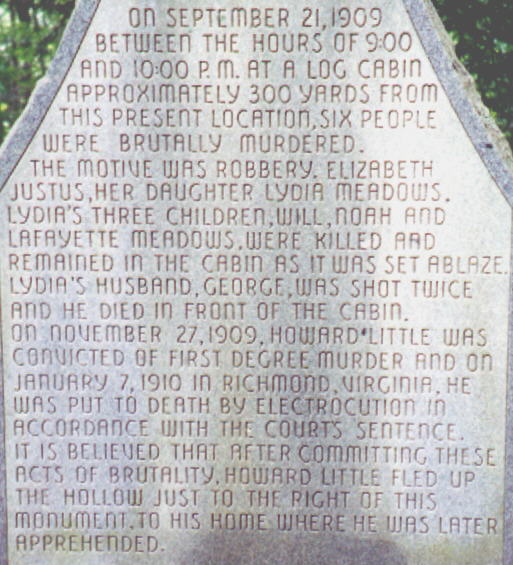
Photo by Pam Norman.
This is a story that has been told and retold in my family for many, many years, sometimes with a little elaboration and sometimes with so little detail that you wonder what actually did happen. I heard it when I was a small child, but it wasn't until very recently that I was able to find out any more detail about the actual event.
The dispositions of the graves of the victims are as follows: George Meadows is buried in a separate grave just to the northwest of the above monument. His stone is rough-hewn and very hard to read:
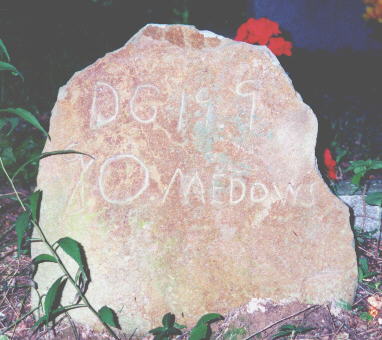
Photo by Pam Norman.
The large granite stone marker sits between the old marker that indicated the graves of Elizabeth, Lydia, and the little boys, and Hiram Wylie Justus' gravesite. Yes, Elizabeth, Lydia, and the three little boys were all buried in the same common grave. The old marker was a very large stone (it must have taken a mule or two to move it!) on which I have heard was scratched "BAK 6." Any writing that was once on it has long since faded. For years this was the only memorial these people had, save for the mutterings of the old people who remembered the crime first-hand.
Well, since I am a descendant of Elizabeth, I am, of course, interested in what happened to her and her children on that horrible September night in 1909. From a variety of sources I was able to acquire a few accounts of the investigation and of the crime itself. From Gwen Boyer Bjorkman in Washington, related to the Bakers through the Thomas Vester Baker line, I acquired a copy of an article written by Detective A. C. Hufford from Bluefield, the investigating officer for this crime. This article was published in The Master Detective Magazine in July of 1935 and entitled "Capturing the Killer of the Cumberlands." Stella Mae Baker Rose of Maryland may be the ultimate source for this document. However, I was able to acquire an original example of the magazine in question from Joe Byfield in England, a darned nice fellow! I spoke to several of the descendants of Elizabeth who provided details that I had not heard elsewhere. There was a very brief account in Nancy Virginia Baker’s book Bountiful and Beautiful: A Bicentennial History of Buchanan County. Sam Varney, Jr., wrote about the crime in his column "Lore and Legend," published in Mountaineer. One source I did not consult was a book written by George Stacy entitled The Man from Knox Creek. My Grandfather scoffed at the book, stating that it was nowhere near the truth. I must agree with Grandpa's assessment, though it was slated as fiction, Mr. Stacy went a long way to make the Justus family a party to the murder. He tells a good tale, but doesn't go far toward telling the truth of the event. From all of these available sources one can derive a picture of what may have happened.
On a hot day in July of 1909, Betty collected $1,300 ($1,650 according to Baker) from Howard Little acting as agent for the W. M. Ritter Lumber Company in Hurley, Virginia, for the sale of some timberland (or perhaps it was for the rights to the timber on her 150 acres on Laurel Creek). She left the Ritter office in Hurley and took it home to do what all mountaineers did: she cached it about her home.
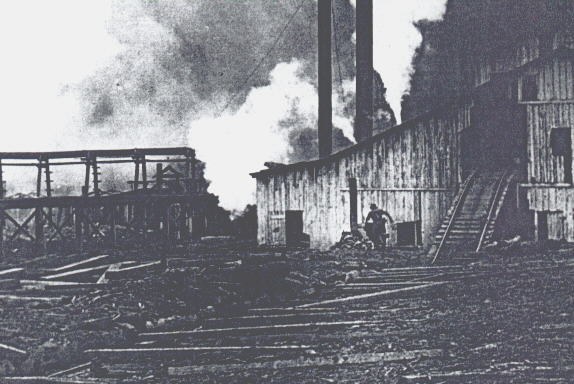
I believe this to be a photo of the Ritter Lumber Mill in Hurley. If Betty sold her timber to this company, she would have collected her money in the office of this building (courtesy of Diane Blankenship and "The Rebel" Restaurant in Hurley).
Since Hiram had died in 1905, Betty had lived with her daughter Lydia and her husband George and their three little boys in her own house. Maybe it was her intention to pass the house on to George and Lydia when she died. Nearby lived a number of the Justus’ relatives, including Betty’s nephew, Sam, who was married to one of Betty’s daughters, Pricy. Down the holler about three hundred yards lived Sennit Justus and his wife Lilabelle, "Lillie."
According to Nancy Virginia Baker, on the night of September 21st, 1909, Howard Little came to visit at Aunt Betty’s and asked if he could spend the night. Since they knew him, they were not suspicious and "opened their home to him" (80). By nine o’clock, the six of them were asleep. It was alleged that Little waited until everyone was asleep before he began his work, using a pistol, a knife, and a hatchet (according to Goldie Baker, Betty kept the hatchet next to her bed for "protection"). Apparently, after dispatching all of the occupants of the house, Little set the cabin on fire and then made good his escape.
Lillie Justice claimed that she heard two gunshots and then saw the orange glow of flames from Aunt Betty’s house. She ran up the holler to the cabin and could see the bodies of Aunt Betty, Lydia, and two of the boys lying on the floor in the flames.

My great great grandfather, Samuel Baker, owned land that bordered Aunt Betty’s (from an original document in the possession of the author).
However, my great grandfather, Matt, who was the son of Samuel, claimed that he was the first to arrive at the cabin as it burned. He saw that the youngest child, Lafayette, was still alive and tried to place him away from the burning cabin, then ran to get help. Little Lafayette, however, managed to fall or climb back down to the burning house where he too was consumed by the fire, the sixth and last victim of this horrible crime. George Meadows was found shortly afterward outside near the fence where he had crawled after being shot twice.
When the fire had died, the neighbors and relatives who went through the smoking ruins of the cabin were met with a most gruesome sight: the charred bodies of Betty and Lydia and two of the children. Goldie Baker also mentioned that Betty had apparently been decapitated. The investigation, led by a detective from Bluefield, A. C. Hufford, aided by Robert Bailey, concluded that a local man, Howard Little from Bull Creek, WV, -- just a short distance (as the crow flies)north of Laurel Creek, had committed the murders and had acted alone.

Alex C. Hufford, the detective from Bluefield who determined, with Robert Bailey, that Howard Little was the guilty man (from The Master Detective).
Howard Little was believed to be the killer, based upon the testimony of his wife and some rather strong circumstantial evidence: namely, a lantern which belonged to the victims which was found on Little's property; Howard had recently suffered some injuries coincidentally and too near in time to the crime; he had also allegedly borrowed a pistol of the same caliber as that which was used to kill George Meadows and had done so only a week or so before the murders. It was also discovered that he had planned on leaving the county shortly before he was captured. Howard had also been found in possession of a large sum of cash.

Howard Little and his wife (photo courtesy of Pat Hatfield at the Buchanan County Public Library).
Howard Little was taken into custody and transferred to the jailhouse in Lebanon for his own safety as there had been rumors that he could be lynched. My great great grandfather, Sam Baker, was part of the "posse" of specially-appointed police constables which escorted Mr. Little to Lebanon Jail.

The special police escort with Howard Little (center left, in cuffs, the only man not armed) in front of Lebanon Jail. My great great grandfather, Sam Baker, is the man furthest to the left (from Tuck and Aileen Baker).
The trial began on November 18, 1909, and was finished three days later. After testimony was heard from his wife and the evidence was presented, the jury came back with a "guilty" verdict. Howard Little was convicted of the murders on Laurel Creek and sentenced to death. He was electrocuted in Richmond on January 7, 1910.
Goldie Baker told me that Betty had several hundred dollars in a metal milk pail hidden beneath the hearth in her house. She had a hundred dollars saved for each of her children. This was in addition to the money she had received from Howard Little and it was not found by the killer or killers. If the sums are correct, Aunt Betty had almost $2,500.00 hidden in various places on her property. It was determined that some of the money from the sale of her timber rights had been taken during the commision of the crime, but not all of it was missing.
There are some who believe that the wrong man was sent to the electric chair. I have heard that bloodhounds were used to track the killer and that they ended up at the house of another Justus man, Lewis, who was one of Betty's sons or nephews. This man apparently had a very good alibi, so they did not pursue him any longer as a suspect. Tracking dogs are not infallible.
I have also heard that, on the day before the murders, Little was seen near Betty's cabin with a Justus man. Another man claimed that he saw Little with Dick Bailey the night of the murders. Little probably did not act alone. There are some who believe that Howard Little was innocent, though I am not one of them. I feel that he had some part to play in the crime, though what I don't know. In the two letters which exist purported to be written by Howard after the crime, he makes no admission of guilt or protestation of innocence. Muriel Oehme of Maryland, a descendant of Howard Little, states that he maintained his innocence until the end. Muriel also told me that Howard's wife was fed up with his womanizing and that that was her motive for testifying against him at the trial. Their estrangement may have been going on for nearly four years when this incident occurred.
Aunt Betty's land was passed on to her children in common and they, in turn, sold their interest in it to Betty's oldest son, Daniel, who purchased it for $150.00, just a little over a dollar an acre. The timber rights, however, still belonged to the W. M. Ritter Lumber Company.
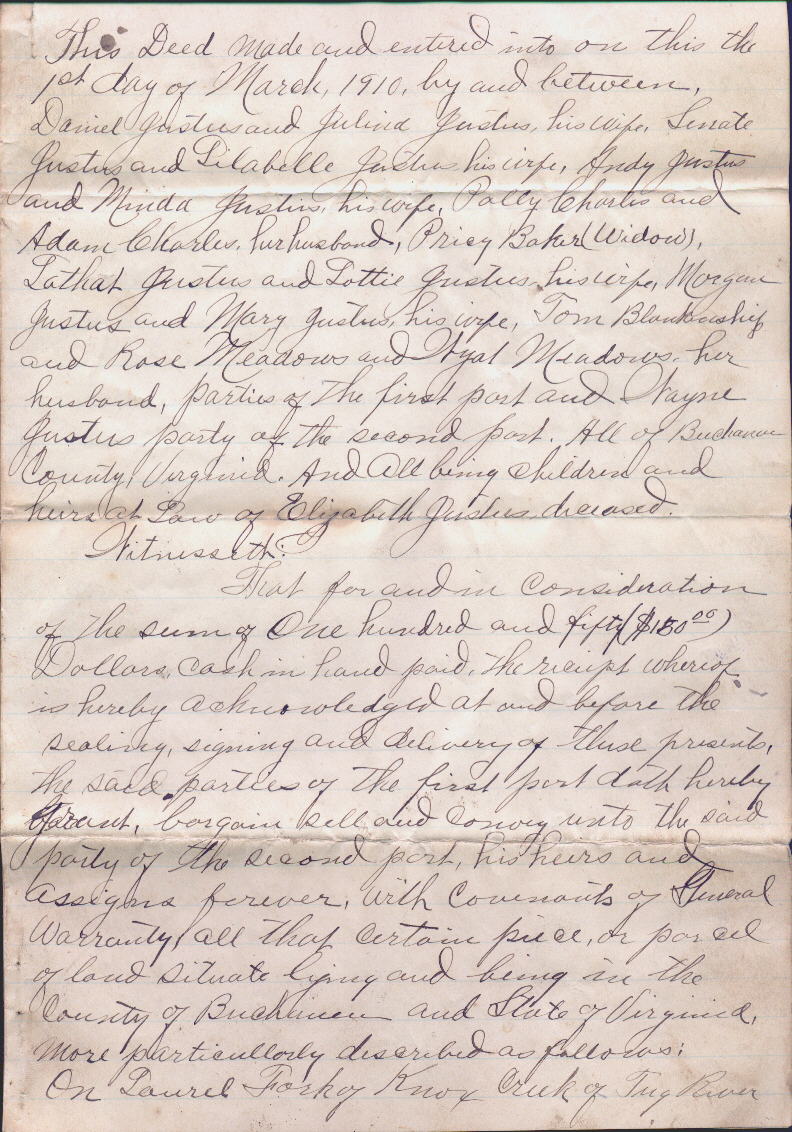
The first page of the deed passing interest in Betty's 140 acres to her oldest son, Daniel Justus (author's collection - thanks to Tuck and Aileen Baker).
One other detail that is interesting to note about this deed is the fact that every one of the children of Elizabeth Justus signed this document "by mark." This line of the family acquired literacy sometime shortly after the turn-of-the-century. I know that my great grandfather was able to read and write, but I don't know if his father, Sam, could do so.
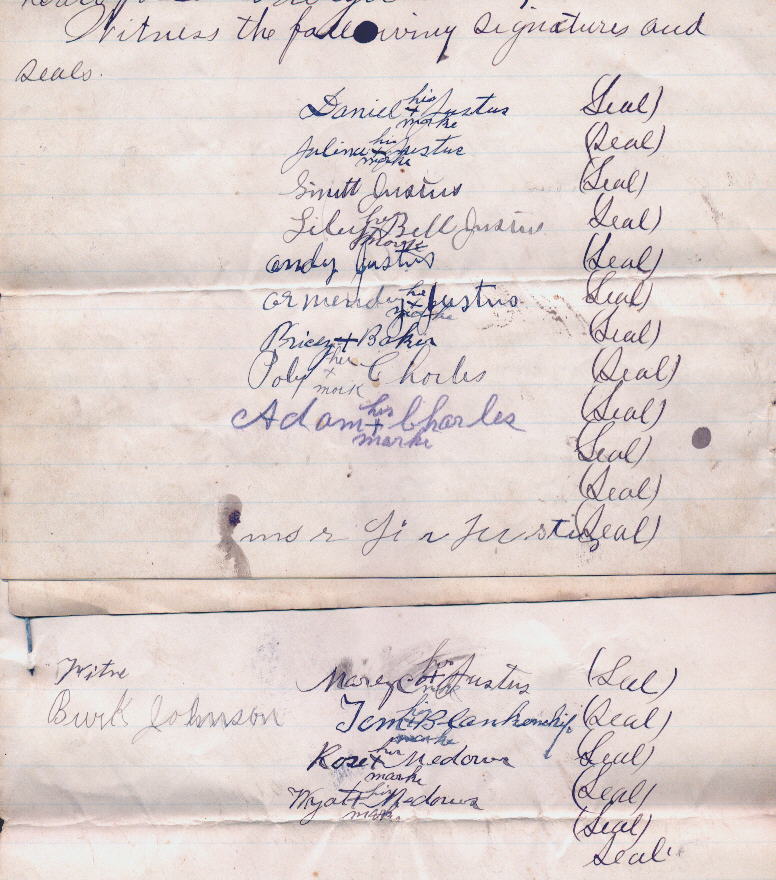
From the Author's collection - thanks to Tuck and Aileen Baker.
In the ninety years since, the Justus-Meadows murders have passed into the mists of time, dimly remembered by only a few. But you, my reader, have stayed with me for this long. Thank you for allowing me to tell my tale, so that I may honor my ancestors, for this is the only tribute that I can pay them: to remember them every once in a while and never let them fade from the back of my mind or from my heart. It is the least that I can do for them.
Dedicated with love to Elizabeth Baker Justus, Lydia Justus Meadows, George Meadows, and Will, Noah, and little Lafayette Meadows.
Robert M. Baker
Return to Rob's Genealogy Page
Return to The 39th Kentucky Mounted Infantry Website











